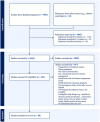Instruments for the assessment of disaster management among healthcare professionals: a scoping review
- PMID: 40290498
- PMCID: PMC12021930
- DOI: 10.3389/fpubh.2025.1540743
Instruments for the assessment of disaster management among healthcare professionals: a scoping review
Abstract
Objectives: The recent disasters have highlighted the importance of healthcare professionals (HCPs) in aiding communities and maintaining consistent services, prompting a global reconsideration of disaster preparedness approaches. This scoping review aimed to identify and evaluate the psychometric properties of the available instruments that measure disaster preparedness and readiness among HCPs.
Methods: A scoping review was conducted using five concepts: disasters, health personnel, preparedness, management, and questionnaire. Three databases were searched for studies published in English. The identified instruments were summarized according to disaster type, disaster management phase, measurement scope/context, and healthcare discipline. The psychometric properties were evaluated according to content validity, response process, internal structure, relation to other variables, and consequences.
Results: The Emergency Preparedness Information Questionnaire (EPIQ) was the most commonly used instrument, while the Provider Response to Emergency Pandemic (PREP) and the Korean version of the Disaster Preparedness Evaluation Tool (DPET) were the most valid instruments. Most instruments have undergone limited psychometric evaluations, primarily focusing on content and internal structure validations, with response process, relation to other variables, and consequences not frequently reported.
Conclusion: The review highlights the lack of well-developed assessment instruments for disaster preparedness in healthcare disciplines, highlighting the need for future research to develop and thoroughly validate such instruments.
Systematic review registration: https://www.researchregistry.com/browse-the-registry#registryofsystematicreviewsmeta-analyses/registryofsystematicreviewsmeta-analysesdetails/638dbba71e82b30021c02680/.
Keywords: assessment instruments; disaster management; healthcare professionals; reliability; validity.
Copyright © 2025 Elshami, Yakti, Mohamed Ibrahim, Awaisu, Sherbash and Mukhalalati.
Conflict of interest statement
The authors declare that the research was conducted in the absence of any commercial or financial relationships that could be construed as a potential conflict of interest. The author(s) declared that they were an editorial board member of Frontiers, at the time of submission. This had no impact on the peer review process and the final decision.
Similar articles
-
Developing and evaluating a Disaster Management Assessment Tool for Health Care Practitioners.BMC Emerg Med. 2025 Mar 6;25(1):41. doi: 10.1186/s12873-025-01199-8. BMC Emerg Med. 2025. PMID: 40050754 Free PMC article.
-
Psychometric Evaluation of the Disaster Preparedness Evaluation Tool© (DPET) on Emergency Nurses in Mainland China: Two Cross-Sectional Studies.Disaster Med Public Health Prep. 2022 Jun;16(3):1083-1090. doi: 10.1017/dmp.2021.39. Epub 2021 May 5. Disaster Med Public Health Prep. 2022. PMID: 33949305
-
Construct validity and reliability of the Chinese version of the Disaster Preparedness Evaluation Tool in Taiwan.J Clin Nurs. 2015 Apr;24(7-8):1132-43. doi: 10.1111/jocn.12721. Epub 2014 Nov 28. J Clin Nurs. 2015. PMID: 25441229
-
Disaster Preparedness among Health Professionals and Support Staff: What is Effective? An Integrative Literature Review.Prehosp Disaster Med. 2017 Jun;32(3):321-328. doi: 10.1017/S1049023X1700019X. Epub 2017 Mar 16. Prehosp Disaster Med. 2017. PMID: 28300525 Review.
-
[Psychometric characteristics of questionnaires designed to assess the knowledge, perceptions and practices of health care professionals with regards to alcoholic patients].Encephale. 2004 Sep-Oct;30(5):437-46. doi: 10.1016/s0013-7006(04)95458-9. Encephale. 2004. PMID: 15627048 Review. French.
References
-
- Giorgadze T, Maisuradze I, Japaridze A, Utiashvili Z, Abesadze G. Disasters and their consequences for public health. Georgian Med News. (2011) 194:59–63. - PubMed
-
- Tichy M, Bond AE, Beckstrand RL, Heise B. NPs' perceptions of disaster preparedness education: Quantitative survey research (2009).
-
- Swiss Re Institute . Natural catastrophes and inflation in 2022: A perfect storm. (2023).
-
- UNDRR . Disaster management. Available online at: https://www.undrr.org/terminology/disaster-management#:~:text=The%20orga... (Accessed November 10, 2024).
-
- Tekeli-Yeşil S. Public health and natural disasters: disaster preparedness and response in health systems. J Public Health. (2006) 14:317–24. doi: 10.1007/s10389-006-0043-7 - DOI
Publication types
MeSH terms
LinkOut - more resources
Full Text Sources
Medical
Miscellaneous


